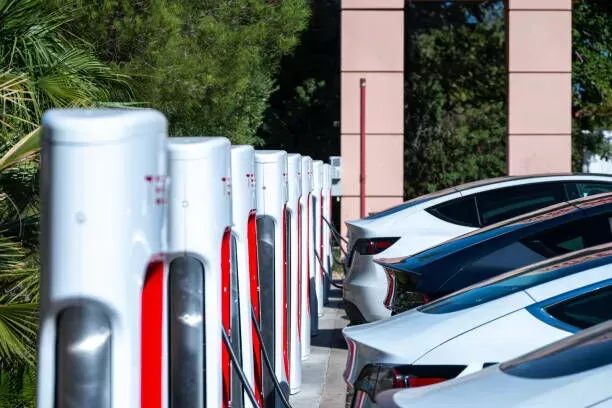Notifications

7 minutes, 9 seconds
-7 Views 0 Comments 0 Likes 0 Reviews

As electric vehicles (EVs) continue their rapid rise worldwide, one challenge remains front and center: charging speed. Ultrafast DC charging—also known as high-power charging (HPC)—is revolutionizing the way we power EVs, delivering lightning-fast charge times that are reshaping the entire electric mobility experience.
With power outputs ranging from 150 kW up to an astonishing 600 kW, ultrafast DC EV chargers can replenish an EV’s battery to 80% capacity in under 30 minutes—and sometimes in as little as 10 to 15 minutes. This isn’t just a boost in speed; it’s a fundamental transformation in how practical and accessible electric driving can be.
To understand the leap forward that ultrafast DC charging represents, it helps to know the basics of EV charging technology.
AC Charging: The electricity in homes and most public outlets is alternating current (AC). When you plug your EV into an AC charger, the vehicle’s onboard charger converts AC into direct current (DC) to store in the battery. This conversion limits charging speed.
DC Charging: Ultrafast chargers perform this AC-to-DC conversion externally and deliver DC power directly to the battery, bypassing onboard limitations and enabling much faster charging speeds.
| Level | Voltage | Charging Speed | Typical Use Case |
|---|---|---|---|
| Level 1 (Standard) | 120V | Adds 3–5 miles of range per hour | Home charging via regular outlet |
| Level 2 (Fast) | 240V | Adds 15–30 miles of range per hour | Residential, workplaces, public charging |
| Level 3 (DC Fast and Ultrafast) | 400–1000V | Adds 100–200+ miles in 15–30 minutes | Highway stops, fleet depots, fast networks |
Ultrafast DC charging is more than just fast—it’s a game changer for the entire EV ecosystem.
Slashing Charging Times: Charging an EV battery to 80% in 10 minutes is now possible, bringing EV refueling times closer to those of gasoline vehicles, easing adoption for all drivers.
Making Long-Distance Travel Feasible: Strategically placed ultrafast chargers along highways erase “range anxiety,” turning EVs into practical options for road trips and intercity travel.
Supporting Commercial Fleets: Delivery, ride-share, and public transit fleets can reduce downtime, boost efficiency, and electrify more vehicles with ultrafast charging solutions.
Expanding Infrastructure Confidence: A robust ultrafast charging network makes consumers feel secure switching to EVs, accelerating the shift away from fossil fuels.
Improving Urban Charging: For city residents without home chargers, quick ultrafast stations offer convenient, high-speed charging without long wait times.
Ultrafast charging depends on cutting-edge hardware and software:
High-voltage vehicle architecture (800V+ systems) built to safely handle rapid power flow
Liquid-cooled charging cables to prevent overheating
Smart communication protocols that optimize charging based on battery status
Advanced thermal management to protect battery health during rapid charge cycles
Popular standards enabling this include CCS (Combined Charging System), CHAdeMO, and Tesla Superchargers, each ensuring high-speed charging with safety and compatibility.
While ultrafast charging offers huge promise, several hurdles remain:
Grid Demand: High-power charging puts heavy loads on local electricity grids, requiring infrastructure upgrades, energy storage, and renewable integration.
Cost: Installing ultrafast stations is capital-intensive, with expensive equipment and site requirements.
Vehicle Compatibility: Not all EVs today can accept ultrafast charging; broad compatibility will take time as automakers adopt advanced battery designs.
Battery Longevity: Frequent ultrafast charging may impact battery lifespan. Innovations in battery tech and charging algorithms are key to mitigating wear.
Around the world, governments and companies are investing heavily in ultrafast charging:
Europe leads with networks like Topper, offering 350 kW chargers on major routes
The U.S. is rolling out the National Electric Vehicle Infrastructure (NEVI) program along interstate highways
China, the world’s largest EV market, is rapidly expanding high-power charging stations to meet soaring demand
By 2030, the global ultrafast DC charging market is expected to top $25 billion, propelled by rising EV adoption and technology advances.
Pairing ultrafast chargers with solar, wind, and battery energy storage systems can ease grid strain, cut costs, and boost sustainability. Energy storage can absorb power during off-peak hours and discharge during peak charging demand, enabling smarter, greener charging networks.
Future ultrafast charging breakthroughs may include:
Wireless DC charging: Cable-free fast charging pads for ultimate convenience
AI-driven load management: Smarter use of chargers to reduce queues and optimize energy
Vehicle-to-Grid (V2G) technology: EVs feeding energy back to the grid as mobile storage units
Compact urban stations: Space-efficient designs for dense city environments
Ultrafast DC charging is not just a technical upgrade—it’s a vital enabler of mass EV adoption. By delivering near gas-station refueling speeds, boosting infrastructure reliability, and supporting a sustainable transportation ecosystem, ultrafast charging is powering the global transition to clean mobility.
For drivers, it means faster, more convenient charging. For businesses, improved fleet operations. For cities and governments, a critical step toward emissions reduction. As EVs and infrastructure evolve hand-in-hand, ultrafast DC charging will lead the charge toward a cleaner, zero-emissions future.Know more about Google SEO Directory
China EV Chargers EV Charger Manufacturer EV Charging Solutions
